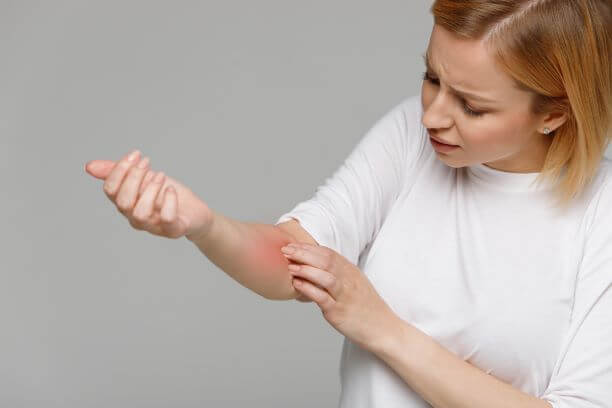Bacterial skin infections are some of the most common skin conditions treated by dermatologists each year. According to Dr. Rasheen Imtiaz of U.S. Dermatology Partners in Baytown and Houston, “Most people will develop a bacterial infection at some point. Being able to identify common bacterial skin infections can help you determine the best steps to take for treatment.” If you’re concerned you may have a bacterial skin infection, don’t wait to reach out to your dermatologist for more information about treatment options. Keep reading to learn more about bacterial infections from Dr. Imtiaz.
What Should I Look for to Identify Bacterial Skin Infections?
Dr. Imtiaz says, “The warning signs of bacterial skin infections will vary slightly depending on the type of skin infection, but there are some basic things you can look for that are typically consistent across different forms of infection.” Some symptoms that are common across the types of infection include:
- Redness or skin discoloration
- Pain or sensitivity
- Swelling and inflammation
- Pus
- Blisters
- Skin breaking down around the infected area
Common Types of Skin Infections
Our skin is the protective barrier that guards our bodies against all types of health concerns, including bacterial infection. The skin is covered in numerous types of bacteria, and most of them are harmless when they remain on the skin’s surface. However, when bacteria enter the body through cuts or scrapes on the skin’s surface, they can cause infections. There are many types of bacterial infections that people should be able to identify to ensure they seek the right treatment, including the following common types:
Methicillin-Resistant Staphylococcus Aureus (MRSA)
MRSA is one of the most severe forms of bacterial infection because it responds to a limited number of antibiotics. It can lead to large abscesses (pus-filled sores). This type of skin infection is very common in hospitals and nursing homes. Treatment typically involves draining the infection or using specific antibiotics if infection cannot be drained.
Cellulitis
Cellulitis can develop on any part of the body, but it occurs most often on the lower leg. The affected area may swell, feel hot to the touch, or be very sensitive. Untreated, cellulitis may cause infection in other parts of the body or enter the bloodstream. Treatment typically includes antibiotics applied topically, taken orally, or in severe cases, administered intravenously.
Impetigo
This type of bacterial skin infection is most common in school-aged children. In appearance, impetigo can cause sores and blisters on the face, hands, neck, or around the diaper in younger children. In most cases, this is a mild infection that clears up with topical antibiotics or mild oral antibiotics.
Necrotizing Fasciitis
You may have heard this condition referred to by its common name, flesh-eating bacteria. This is a serious bacterial skin infection that can be life-threatening if untreated because it can quickly spread to other tissues or enter the bloodstream. In most cases, treatment for this condition is very aggressive and includes intravenous administration of antibiotics and surgical removal of infected tissue.
Folliculitis
This type of bacterial infection begins in the hair follicle, the part of the skin where your hair’s root is encased. Folliculitis causes itching, burning, sensitivity, or tenderness. While most cases of folliculitis are bacterial infections, this condition may also be caused by viral or fungal infections. This is a mild form of skin infection that often clears up on its own, but you should seek treatment if it spreads or worsens.
Boils (Furuncles)
These are sores in the skin that often present as tender, red-colored bumps. Over time, boils fill with pus and break open. They most often develop in hair follicles. In most cases, applying a warm compress to the boil is enough to ease the discomfort and help the infection drain. If the infected area is very painful or large, your dermatologist may recommend surgically draining the boil by making a small incision in the infected area.
Carbuncles
Carbuncles are actually a cluster of boils. In most cases, you’ll need to seek professional treatment for carbuncles as they can be very painful and are less likely to drain on their own than an individual boil.
Erysipelas
Often referred to as St. Anthony’s Fire, this bacterial infection is characterized by a burning sensation in the affected area. It looks very similar to cellulitis, but the painful heat or burning feeling experienced by individuals with erysipelas differentiates the two types of bacterial skin infections. To treat this condition, you’ll receive antibiotic medications, and your dermatologist may also provide medicines that reduce pain and fever.
Erythrasma
This a bacterial infection that impacts the surface layer of skin, causing dark, often red or brown -colored, patches of skin that appear wrinkled or scaly. This condition almost always develops in areas with skin-to-skin contact. It can look and feel similar to fungal infections like athlete’s foot. Although the symptoms are typically very mild, erythrasma should be treated to prevent it from spreading to surrounding areas. The condition is typically treated with oral and/or topical antibiotics.
Treating Bacterial Skin Infections
According to Dr. Imtiaz, “The best treatment for bacterial infections depends mainly on how severe the infections are. Mild skin infections may improve on their own, but moderate to severe infections need to be treated by your dermatologist. If an infection becomes more severe instead of improving with at-home care, you should seek professional treatment right away.” Common treatment options for bacterial skin infections include:
- Topical antibiotic ointments – Both over-the-counter and prescription-strength antibiotic ointments may be recommended to address skin infections.
- Oral antibiotics – If the bacterial infection doesn’t clear with the use of topical antibiotics, oral antibiotics may also be prescribed. In very severe cases, your doctor may need to administer antibiotic injections.
- Draining – For abscesses and boils, your dermatologist may make a small incision in the skin to drain the infection. Do not perform this procedure at home, as doing so can increase your risk of spreading the infection to other areas.
Preventing Bacterial Skin Infections
Bacterial skin infections typically begin from a cut in the skin. Bacterial infections can enter the skin through an area as small as a paper cut, a wound from improperly popping pimples, or through larger surgical site incisions. To reduce the risk for bacterial infections, cuts or wounds should be cleaned frequently with antibacterial soap and water. Hands should also be washed more frequently, especially before cleaning or treating the area impacted by a bacterial infection. If possible, the infected area should also be covered with sterile gauze.
Visit U.S. Dermatology Partners
If you require treatment for a bacterial infection or it’s time for your annual skin health exam, the U.S. Dermatology Partners team is here to help. Getting started with our practices is simple. You can complete our online scheduling request form at any time. Once we receive your request, we’ll be in touch to finalize your appointment details.
Find a location near me
or


